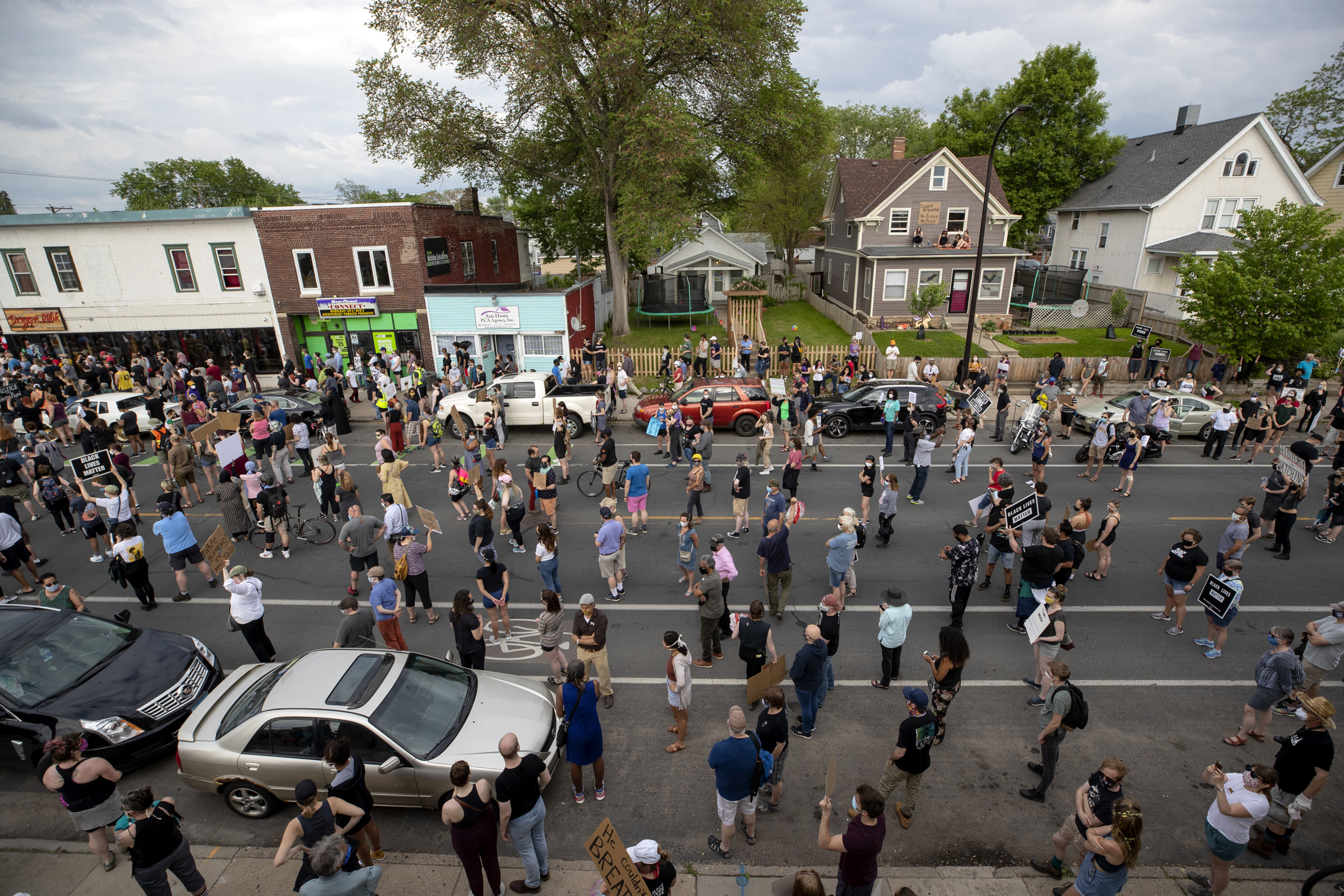A narrative, by its nature, is a contained thing. Some bits get trimmed out in the interest of coherence. Some get cut for time or space. Always, a storyteller makes choices, choices that are informed by her worldview, to collect material in support of a thesis, a plot. But life, by contrast, is a mess.
For the most part, journalism has decided that the coronavirus and the killing of George Floyd, a forty-six-year-old Black man, in Minneapolis, are two distinct stories. That’s fiction. Floyd’s murder, under the knees of a white police officer—and the demonstrations in response—occurred as part of a cascade of events. There is the history of systemic racism in America, police brutality, and protest. There is the spread of covid-19, the disease caused by the new coronavirus, and its economic effects. Floyd had worked as a security guard, alternately at a Salvation Army and a club called Conga Latin Bistro, which closed amid the mass shutdown of bars and restaurants. On Memorial Day, he walked into a corner store for a pack of cigarettes; he was arrested for allegedly trying to pay with a fake twenty-dollar bill. His punishment was death. An autopsy report later showed that Floyd had been infected by the coronavirus before he was killed. His last words were the same as those of so many Black Americans: “I can’t breathe.”
Donald Trump, too, is part of the story. As people began pouring into the streets—first in Minneapolis, then across the country and all over the world—the president of the United States suggested that they should be shot. Trump’s comment—cribbed from Walter Headley, a former police chief in Miami who in December 1967 promised that racial uprisings would be met with violence—came not long after he’d expressed support for those who stormed their state capitols in opposition to measures intended to curb the spread of the coronavirus. The Centers for Disease Control and Prevention has observed that covid-19 disproportionately harms racial and ethnic minorities.
The web of connections is intricate and vast. In recent days, many journalists—and those following the news—have used the word overwhelming to describe this moment. Yet it’s important to acknowledge that the situation did not arise suddenly. To properly contextualize our reporting, we must look at how we got here, turning back at least as far as the beginning of the calendar year.
JANUARY
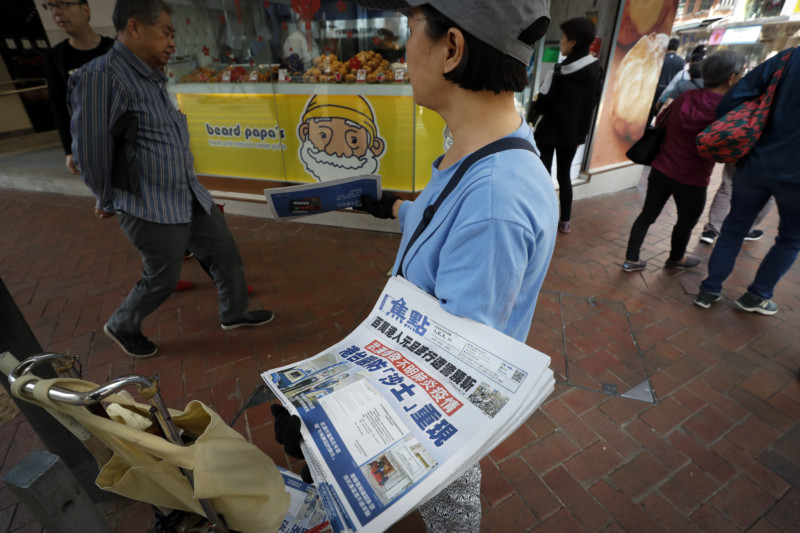
AP Photo/Andy Wong
On New Year’s Eve, Chinese health authorities identified a cluster of pneumonia cases in people who had been to the Huanan Seafood Wholesale Market in Wuhan, Hubei Province. Within a week, it was confirmed that these people were sick from something associated with a novel coronavirus, which became known as 2019-nCoV. The general public remained mostly unaware of the outbreak, however, until January 20, when President Xi Jinping issued a statement promising to “resolutely curb the spread of the epidemic.” By that time, the coronavirus had traveled across the world. The same day, a thirty-five-year-old man in Snohomish County, Washington, became the first confirmed case of infection in the United States. Li Wenliang, an ophthalmologist at Wuhan Central Hospital, spoke out with increasing boldness about the need to broadcast information, in spite of China’s strict policies on censorship; he was among hundreds of people who were reprimanded or detained for “spreading rumors” about the virus. Soon, Li died of complications of covid-19. Most of the world was slow to appreciate the seriousness of his warnings; some outlets covered the story mainly through the lens of stereotypes.
FEBRUARY
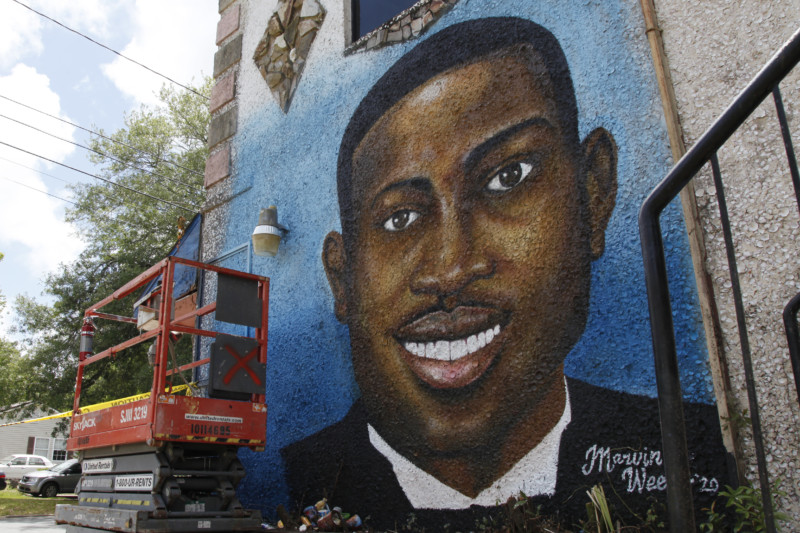
AP Photo/Sarah Blake Morgan
On February 23, a twenty-five-year-old Black man named Ahmaud Arbery went for a jog. He was in Brunswick, Georgia, where the afternoon sun was out, making shadows of the leaves of the trees. Behind him, in a pickup truck, were Gregory McMichael, a retired investigator for the Brunswick Judicial Circuit district attorney, and his son Travis. They were white; they were armed. They called the local police to report Arbery. “What is he doing?” the dispatcher asked. The answer: “He’s running down the street.” While the conversation continued—and the dispatcher promised to send an officer out—Travis McMichael stepped out of the truck and fired shots at Arbery, who died at the scene. The McMichaels told police that they believed Arbery had been breaking in to a home; they referred to a rash of recent burglaries. According to the Brunswick News, however, there had been just one: a gun stolen from an unlocked car outside Travis’s place. The story was not reported for weeks, until local media got hold of the police report. It would be months before Arbery’s name entered the national news.
Meanwhile, more reports of the coronavirus were appearing outside Asia. February 14 brought the first covid-19 death beyond the continent’s borders; the deceased was an eighty-year-old Chinese tourist in France. Ten days later, the Dow Jones Industrial Average plummeted to its worst close in two years. Within a week, Americans learned of the first coronavirus-related death in the United States—a man in his fifties, in Washington State. Yet the story, when it received coverage at all from American outlets, was still largely focused on China: on the Xi administration’s cover-up of the spread of covid-19, on the impact on US-China trade, and on conspiracy theories related to the origins of the virus. On February 22, the Global Times—a tabloid published by the People’s Daily, a Chinese Communist Party mouthpiece—suggested that the coronavirus did not originate in the Huanan market. Rumors circulated that the virus was a biochemical weapon developed by the US military. On February 23, around the time Arbery’s body lay on the ground, Trump told the press, “President Xi loves the people of China, he loves his country, and he’s doing a very good job with a very, very tough situation.” As for the US, Trump said, “We have it very much under control.”
MARCH
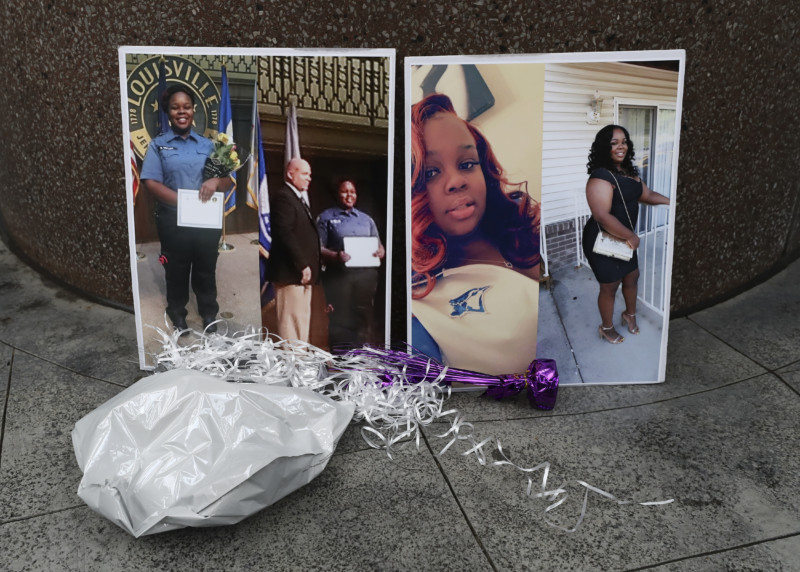
Sam Upshaw Jr./Louisville Courier Journal
Over the course of March, in the eyes of the American press, the coronavirus story went from being a distant concern to an immediate crisis. The World Health Organization (WHO) designated covid-19 as a pandemic and, on March 13, declared that Europe had become the epicenter, reporting more cases and deaths there than in the rest of the world combined. Several states—including Michigan, Pennsylvania, and Maryland—announced plans to close schools. The same day, an emergency room technician named Breonna Taylor was shot eight times, to her death, by police officers who had used a battering ram to enter her apartment. Taylor, a twenty-six-year-old African-American woman, had been asleep; the officers had executed a “no knock” warrant. What the cops were looking for wasn’t there. The story did not make headlines in mainstream national publications.
Coverage of the public health crisis, however, was gaining traction. On March 15, twenty-nine more states—including New York, Massachusetts, South Carolina, and Hawai‘i—closed schools. The CDC released guidelines recommending that no events with more than fifty people be held; the next day, Trump told Americans to avoid gathering in groups of more than ten and to stop going to restaurants and bars. Wall Street took a nosedive.
On March 18, the United States closed its borders to all “nonessential traffic” and suspended refugee admissions. Trump signed a coronavirus aid bill into law. Not in the news: Monika Diamond, a thirty-four-year-old transgender Black woman, who was killed in Charlotte. Diamond was active in the local LGBTQ and nightlife community and was the co-CEO of the International Mother of the Year Pageantry System, which honors LGBTQ mothers.
On March 20, the market tanked again. The US faced its worst economic week since the 2008 financial crisis. Days later, American coronavirus cases topped fifty thousand; the number of deaths passed a thousand. By the end of the month, US cases surpassed the total in China. On March 28, the covid-19 death toll reached two thousand. The same day, local New York media reported, a thirty-three-year-old transgender woman known as Lexi of the House of Ebony was fatally stabbed. She was a sex worker in Harlem who liked to read poetry.
APRIL
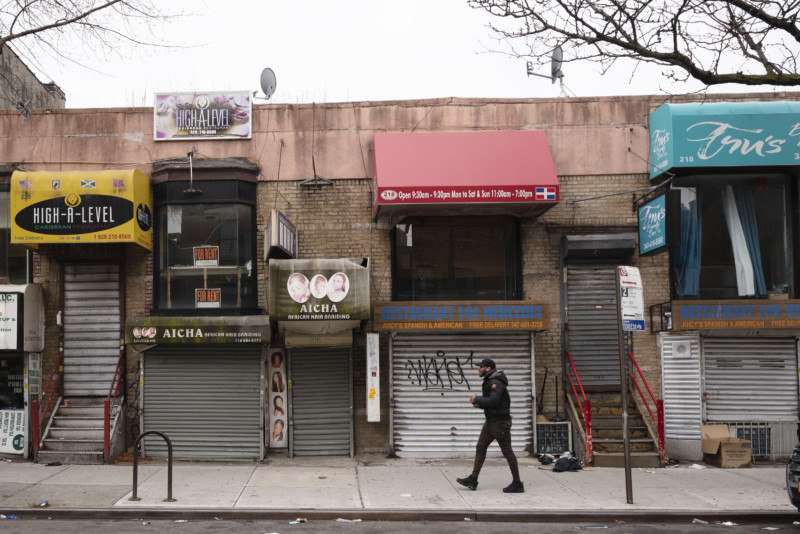
AP Photo/Mark Lennihan, File
The month of April brought devastating job losses. Week after week, the number of Americans filing for unemployment benefits broke records. By month’s end, thirty million people—about 18 percent of the workforce—were jobless. That did not count anyone who worked on a freelance basis, who would not be eligible to file, or anyone undocumented who didn’t qualify for unemployment insurance. According to the Economic Policy Institute, Black workers saw greater losses in employment than white workers did—more than one in six Black workers lost their jobs between February and April, per a recent report—and, as of April, under half the Black population was employed. The hardest-hit group was Black women: between February and April, 18.8 percent lost their jobs.
The effect of the coronavirus on income—especially in the Black community and among Latinos—compounded existing inequality in American households: Black and brown people tend to have lower wages, fewer earners in a family, and less generational wealth. Many of those deemed “essential workers” felt they had no choice but to report for duty; fewer than one in five Black workers could do their job from home. These factors contributed to the results of a report released in April by the CDC, which found that African Americans had been diagnosed with covid-19 at disproportionately high rates. Coverage of this data often omitted mention of Black patients’ employment or housing stability, focusing instead on the fact that people of color reside in “large urban cities.”
At the time, increasingly large groups of people—most of them white—were gathering at statehouses across the US to protest stay-at-home orders. In North Carolina, Missouri, Wisconsin, Michigan, Minnesota, and Virginia, demonstrators railed against measures aimed at halting the spread of the coronavirus, including the wearing of face coverings. Maskless—and sometimes bearing guns—they called for businesses to reopen. Trump encouraged these rallies in tweets and at press conferences. Soon he announced that he was temporarily suspending immigration to the United States in response to the coronavirus pandemic and the “need to protect jobs.” During a briefing, he suggested, offhandedly, that Americans might try injecting disinfectants into their bodies. News organizations went to great lengths to debunk that dangerous claim. At the following day’s briefing, when asked about it by a member of the press, Trump replied, “I was asking a question sarcastically to reporters like you, just to see what would happen.”
EARLY MAY
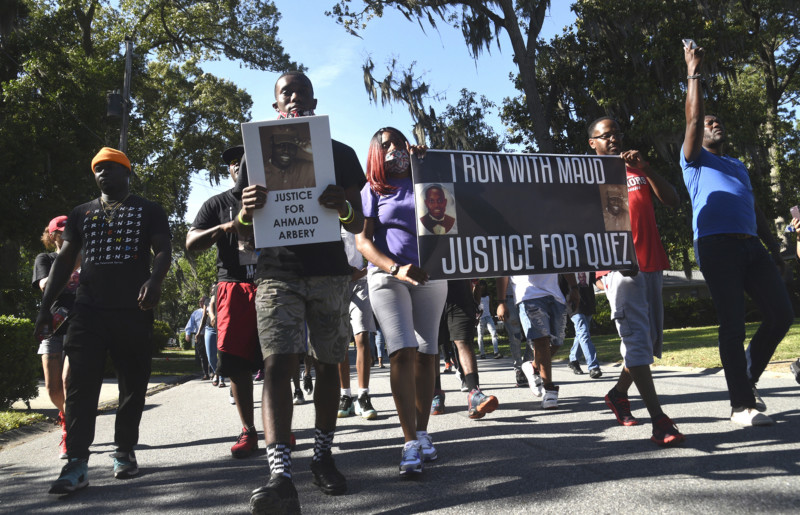
Bobby Haven/The Brunswick News via AP
On the first Sunday in May, Nina Pop, a twenty-eight-year-old Black trans woman, was found dead in her apartment in Sikeston, Missouri. She had been stabbed. Pop, who worked at a fast-food restaurant in town, was written about by the AP, which remarked on “a rash of similar killings so far this year.” The article quoted Tori Cooper, of the Human Rights Campaign’s Transgender Justice Initiative. “For the past four weeks, we have seen the deaths of five transgender women of color in this country. We are seeing an epidemic of violence that can no longer be ignored,” Cooper said. “Transgender and gender non-conforming people, especially trans women of color, risk our lives by living as our true selves—and we are being violently killed for doing so.”
On May 5, the WHO revealed that a case of covid-19 had appeared in France in December of last year. The sickness, as it turned out, had been with us all for longer than we’d realized. The same day, a lawyer working for the family of Ahmaud Arbery released a video that appeared to depict his murder.
On May 6, celebrities—including Ava DuVernay, LeBron James, Kim Kardashian, and Taylor Swift—shared the Arbery footage on social media, driving major press attention and more clicks.
Joe Biden—the presumptive Democratic nominee for president, whose campaign had gone fully digital—said during a virtual roundtable with African-American leaders that Arbery was “lynched before our very eyes.” Carlos Ernesto Escobar Mejia, a man who had fled violence in El Salvador and was now being held by Immigration and Customs Enforcement, became the first person in federal immigration detention to die of coronavirus-related illness. He was fifty-seven. That evening, a twenty-one-year-old man named Desjean Reed, who went by Sean, was driving in his Toyota Corolla on the north side of Indianapolis. Kendale Adams, the deputy chief of the Indianapolis Metropolitan Police Department, spotted Reed, began to chase him, and radioed for reinforcement. Reed streamed on Facebook Live, in view of some twenty-five hundred people. “You gotta look,” he told them, pointing his phone’s camera toward the cop car behind him. As he drove on, he said, “I’m not going to jail today.” Then he pulled over, and appeared to get out of the car. By that point, four thousand people were tuned in. They could hear muffled sounds and pops of gunshots; the camera’s lens turned skyward. Sixteen thousand viewers now. A man’s voice could be heard, apparently from among a group of officers at the scene: “I think it’s going to be a closed casket, homie.”
Protesters gathered where Reed died. Police met them there in riot gear. Reed had been in the Air Force, as RTV6, the ABC affiliate in Indianapolis, reported; he was last stationed at the Joint Base San Antonio in Lackland, Texas, where he served as an airman first class. Amanda Starrantino, the RTV6 evening anchor, told viewers, “Police have not confirmed whether a Facebook Live video viewed and shared thousands of times shows the shooting as it happened.” As the night wore on, and morning dawned, local police shot and killed another Black man—McHale Rose—and a cop car struck and killed Ashlynn Lisby, a white woman. Lisby was pregnant; the fetus did not survive. More rallies followed.
By this time, on May 7, the Arbery video had gone viral. Pressure was mounting that something be done. Ahead of a coronavirus press briefing, Georgia’s governor, Brian Kemp, a Republican, made note of the case. “Earlier this week, I watched the video depicting Mr. Arbery’s last moments of life,” he said. “I can tell you it’s absolutely horrific and Georgians deserve answers.” Within two hours of Kemp’s comment, the McMichaels were arrested on charges of murder and aggravated assault. More than two months after Arbery was killed, the story finally made national news.
The next day, May 8, would have been Arbery’s twenty-sixth birthday. Many of the same people who circulated the footage of his murder on social media now organized a virtual protest, using the hashtag #RunWithMaud. Participants were encouraged to go 2.23 miles, in honor of the date of Arbery’s death. While word went around, the US Labor Department reported that the country’s unemployment rate had leaped to its highest level since the Great Depression; 20.5 million people had lost their jobs. Later in the day, as runners documented their tributes to Arbery, another suspect came under investigation: William “Roddie” Bryan, a neighbor of the McMichaels’, and the man who filmed the killing. When asked at a news conference if the case would be considered a hate crime, Vic Reynolds, the director of the Georgia Bureau of Investigation, pointed out that Georgia has no hate-crimes law. The Atlanta Journal-Constitution obtained another video of Arbery’s death, from a source outside the GBI; it appeared to be from a home security camera about a block away. As social media reacted, with grief and anger, Black journalists and others commented on the problems inherent in disseminating videos of marginalized people dying. The arguments, which had been made before, over the years of numerous extrajudicial killings in the digital media age, went roughly like this: On the one hand, the images are striking and inspire non-Black viewers to respond. On the other, the images become ubiquitous and traumatic to Black people, who never needed to watch a clip to become aware of racist brutality.
There was another concern, too, about relying on horrifying videos to spark a response to white-on-Black violence: “Arbery’s murder, for example, only took hold in the national press after footage depicting his death was uploaded; in Taylor’s case, by contrast, there is no video, and her death has received relatively less coverage.” On May 12, while Anthony Fauci, the director of the National Institute of Allergy and Infectious Diseases, testified at a public Senate hearing about America’s coronavirus response, warning of dire consequences should the country reopen for business too soon, Taylor’s mother, Tamika Palmer, spoke out in the local Louisville press. Her family had still received no answers to explain why Breonna was dead.
MID-MAY
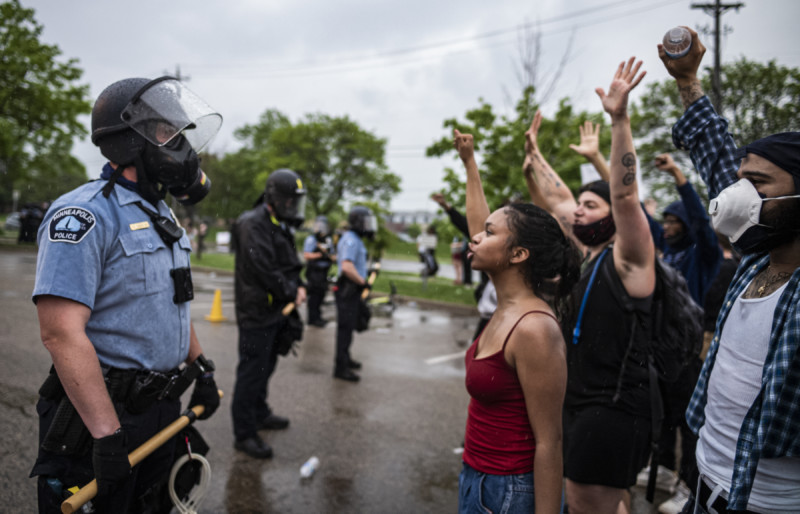
Richard Tsong-Taatarii/Star Tribune via AP
The number of Americans who had succumbed to covid-19 neared an astonishing hundred thousand. Grief blanketed the country. Some mourned with their families, others alone; many felt at a loss for a collective experience through which to express their despair. George Floyd, who was forty-six, had recently found himself out of a job as a bouncer at Conga Latin Bistro, a restaurant and club in north Minneapolis. Originally from Houston’s Third Ward, he was known as “Big Floyd.” At 6′6″ he towered over everyone; his height seemed a measure of his spirit. Before moving to Minnesota, Floyd had been an active member of the Third Ward’s Christian community, coordinating ministry outreach with the Resurrection House, a local church. It was warm the day he died: on May 25, Minneapolis hit 78 degrees, a prelude to summer. Floyd entered a grocery store called Cup Foods on 38th Street and Chicago Avenue, on the city’s south side, around 8pm. He wanted a pack of cigarettes. He handed a twenty-dollar bill to the cashier, who suspected it was counterfeit and called the police. Two officers responded, and they identified Floyd, who was by then sitting in a parked car across the street. Soon, more cops arrived. Surveillance video shows the officers handcuffing Floyd and leading him to the side of a nearby building, where an officer named Derek Chauvin, a white man, pinned Floyd’s neck to the ground with his knee. The whole of Chauvin’s body weight pressed into Floyd’s airway, for nearly nine minutes. The other officers—Thomas Lane, J. Alexander Kueng, and Tou Thao—stood watch as Floyd gasped for air. He cried out for his mother. “I can’t breathe,” he managed to say. Bystanders shot video, pleading with Chauvin to get off Floyd’s neck. But it was too late. Floyd lost consciousness; his body went limp. Even still, Chauvin’s knee remained lodged on his neck. By the time fire and medical personnel arrived, they found Floyd with no pulse. He was pronounced dead at 9:25pm at Hennepin County Medical Center. A video shot by a bystander depicting his death went viral. It was later reported that Floyd and Chauvin had once worked security shifts at the same nightclub.
Early the next morning, the Minneapolis Police Department released a statement: Floyd had died of a “medical incident” while in police custody. It did not mention that Chauvin’s knee had been on Floyd’s neck. But the Hennepin County medical examiner’s office ruled the death a homicide; later, a private autopsy conducted at the behest of Floyd’s family would reach the same conclusion, implicating Chauvin and the two officers who helped pin Floyd down. On the morning of May 26, Jacob Frey, the mayor of Minneapolis, held a press conference in which he condemned the behavior of the officers involved. “For five minutes, we watched as a white officer pressed his knee into the neck of a Black man. For five minutes,” he told reporters. “When you hear someone calling for help, you are supposed to help. This officer failed in the most basic human sense.” The four officers implicated in Floyd’s death were placed on paid administrative leave, then fired. Protesters began to gather near where Floyd had been killed. They brought signs that read “I Can’t Breathe”—a chilling echo of Eric Garner, a Staten Island man killed in 2014 by a white police officer who put him in a chokehold. Thousands marched from Cup Foods to the Third Precinct—the city’s largest, and the headquarters of patrol officers and the community crime prevention team. The tension was palpable; the city had not yet released the names of the officers responsible for murdering Floyd. People threw water bottles; police responded with tear gas and rubber bullets.
By Wednesday, the names of the cops—and their disciplinary records—were released and reported in the press. Chauvin’s was especially damning: he had been implicated in multiple shootings—“officer involved,” in cop-speak. Thao had been sued for “use of force” in 2017. Reuters called Floyd’s killing “racially charged.” That night, protesters again gathered near Cup Foods and marched to the Third Precinct; police again attacked them, using rubber bullets, tear gas, and stun grenades. Several stores were looted; an Autozone, a Wendy’s, and an apartment building were set on fire. National media snapped up the images and began to frame coverage of the demonstrations around looting, setting up a dichotomy in which protesters were classified into good guys and bad. Headlines and chyrons used words like chaos and rage and rampage to describe the civil unrest, particularly in Minnesota, where there are wide gulfs between Black and white residents when it comes to wealth and health. The owner of a pawnshop shot and killed a man he thought was attempting to burglarize his store.
As the media turned its sights on Minneapolis and the response to Floyd’s death, another Black victim of police brutality received less notice. Tony McDade, a thirty-eight-year-old trans man, was shot by an officer in Tallahassee, Florida. He’d been attacked by a group of men, McDade said in a video posted to Facebook, and was prepared to defend himself. He also predicted a confrontation with cops (“I am killing and going to be killed because I will not go back into federal prison”), which may have suggested that he had so-called police-assisted suicide in mind. Out magazine reported that McDade marked the third “officer involved” fatal shooting in Tallahassee in two months, and the eleventh reported death that year of a trans or gender-nonconforming person.
On Thursday, protesters in Minneapolis took to the streets for a third consecutive night. Tim Walz, the governor of Minnesota, signed an executive order declaring a “state of peacetime emergency” and militarized the city, activating the National Guard. Around 10pm, protesters entered the Third Precinct. Local media reported that explosives were thought to be in the area; the building was evacuated. Soon, it was set ablaze. Clouds of gray smoke wafted upward. Within minutes, the Minnesota National Guard tweeted that it had activated five hundred troops at Mayor Frey’s request. Press reports led with flames.
The next morning, the previous night’s damage came into clear view: hundreds of fires had burned around the city overnight. Just after 5am, Omar Jimenez, a journalist for CNN, was there, reporting live, as protesters continued to mill around. Police in riot gear approached him. Jimenez, who is Black, was surrounded by a camera crew and producers, who repeatedly told the officers that he was a member of the press. The journalists asked where they should move. The cops arrested Jimenez while the camera kept rolling—and ignored him when he asked why he was being arrested. Soon, his entire crew was handcuffed and led away. An officer picked up the camera, apparently unaware it was still on. CNN hosts in the studio watched, aghast. Nearby, a white CNN reporter was also approached by police but allowed to stay.
In the early morning hours of May 29, Donald Trump logged on to Twitter. Having watched the coverage of Minneapolis, he labeled protesters “thugs.” He added, “When the looting starts, the shooting starts,” invoking Walter Headley, the former police chief in Miami who had used those words during a news conference in 1967. Headley’s quote was later considered to have been a contributing factor to an uprising that broke out in Liberty City, a Black neighborhood, the following August. Twitter, for the first time in its history, blocked a sitting president’s tweet for violating its code of conduct; Trump’s message had broken a rule against glorifying violence. Meanwhile, for the first time since at least the seventies, the White House announced that it would not release summertime economic projections. The country was in a hole; the Trump administration hoped that Americans would place our attention elsewhere.
WEEKEND OF MAY 29
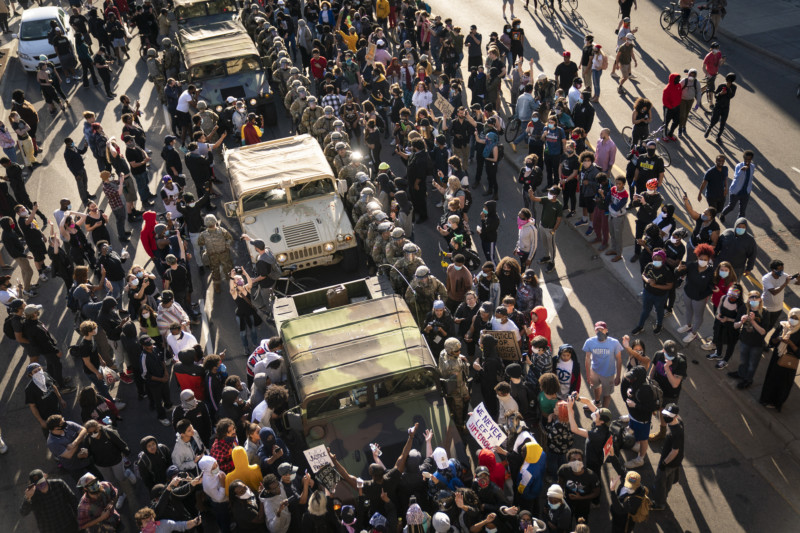
Renee Jones Schneider/Star Tribune via AP
Four days after Floyd was killed, protests sprang up across the country. Police swarmed. They continued shooting rubber bullets into crowds; citizens, including journalists, were hit; the images were posted to social media. The wounds were swollen and red and bleeding. Police continued spraying tear gas; in a video posted to Twitter, a tank rolls down a residential street in Minneapolis as officers follow, yelling at residents standing on their own front porches and firing paint canisters at them. The canisters pop like bullets. News outlets used passive language to describe police violence, active voice to describe those participating in protests. The New York Times shared a story about journalists injured while covering the unrest: “Protesters struck a journalist with his own microphone,” the article said, whereas “a reporter was hit by a pepper ball” shot by police. Stories and chyrons flashed the words riot and looting with little context—and virtually no discussion of unrest as a legitimate form of protest in American history or its strategic use to thin out police forces, rerouting them to prevent them from brutalizing activists. Some stories presented acts of civil disobedience as aberrations—as if a sudden current of violence had bubbled to the surface—and implied that allegedly violent protesters had provoked police aggression. The Chicago Tribune put this phrase on its front page: “Protests give rise to chaos.” The press also largely failed to frame the protests—including vandalism and fires—as a late act in a long drama. These actions came in response not just to the deaths of Floyd, Taylor, Arbery, and McDade, but to the never-ending list of Black people killed by police over many decades: Philando Castile, Alton B. Sterling, Freddie Gray, Tamir Rice, Laquan McDonald, and Garner, to name a few of the most recent examples.
At least twenty-five cities in sixteen states imposed curfews as a means of quelling the uprisings. In Los Angeles and Atlanta, the National Guard was deployed. On May 30, the Pentagon put military police at Fort Bragg, North Carolina, and Fort Drum, New York, on alert for potential deployment to Minneapolis. The Minnesota National Guard authorized more than ten thousand troops to descend on the city. Police and elected officials began to disseminate a narrative to explain the property damage across the country, a familiar communications strategy meant to obscure legitimate social unrest: “Outside agitators,” they said, were responsible for causing chaos. On social media, accounts circulated offering conflicting, anecdotal reports of white protesters and undercover cops antagonizing uniformed officers and damaging property at the expense of Black organizers. In Saint Paul, police claimed that vehicles with no license plates carried “tools to wreak havoc.” The drivers, police said in a tweet, fled on foot. On Saturday, Governor Walz said that 80 percent of the people arrested on protest-related charges were from out of state, describing their behavior as “domestic terrorism” motivated by “ideological extremism.” Mayor Frey echoed this claim. “They are coming in largely from outside the city, from outside the region, to prey on everything that we have built for the last several decades,” he said. Other mayors made similar arguments, which were picked up in press reports. By the end of the weekend, however, journalists had reviewed arrest logs and found that, in Minneapolis, most people arrested had local addresses. Slate received well-deserved praise for its headline “Police Erupt in Violence Nationwide.”
The Atlantic published an article acknowledging that mass protest amid the pandemic could set off a new wave of infections. “There’s little doubt that these protests will translate into increased risk of transmission for covid-19,” Maimuna Majumder, a computational epidemiologist at Boston Children’s Hospital and Harvard, said. Nevertheless, she supported the demonstrations. “Structural racism has been a public-health crisis for much longer than the pandemic has.” Days after his killing, an autopsy report revealed that Floyd had coronavirus. It turned out that his cause of death was “cardiopulmonary arrest complicating law enforcement subdual, restraint, and neck compression.”
NOW
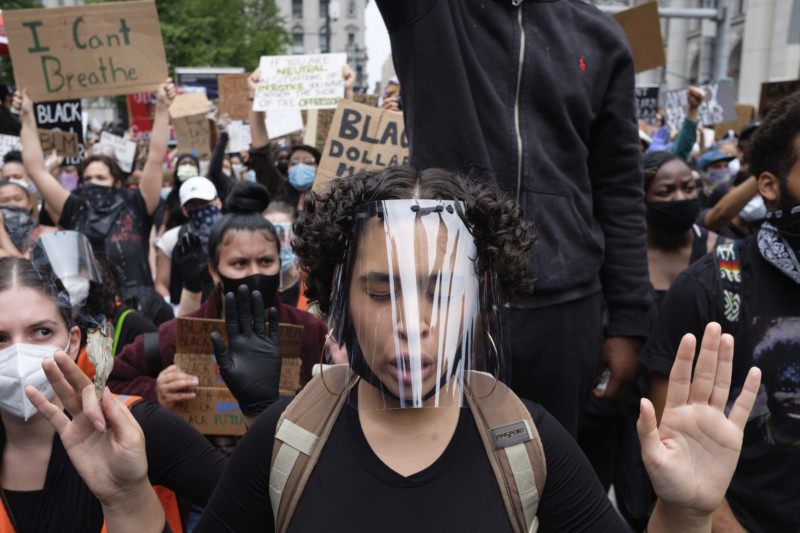
AP Photo/Yuki Iwamura
The days are filled with mourning, the nights with shouts. As of this writing, police have arrested more than nine thousand people. A woman in Austin fell to the ground, having been struck in the abdomen by rubber bullets. “My baby!” she cried—she was pregnant. Some protesters have been killed. “At least five deaths have occurred amid unrest, while other deaths have taken place nearby but their ties to protests are uncertain,” the New York Times reported. “Several people have died nationwide in the protests,” per the Washington Post. “Skirmishes continued into the early morning hours as cops continued to disperse the crowd while people drove around city streets squealing their tires and hanging out windows,” according to the Detroit News. Not every life lost on the streets has been at the hands of cops—in Detroit, for example, a twenty-one-year-old man was sitting in his parked Dodge Caliber, in the vicinity of that city’s demonstrations, when he was shot and killed by a guy about his age. In Omaha, a twenty-two-year-old Black man, James Scurlock, was shot and killed while protesting by a local bar owner, who was white; the Omaha World-Herald has since reported that the shooter, Jake Gardner, will not be charged with a crime.
To a large degree, characterizations of the events, on television and in print, have suggested a chaotic flurry of outrage, with attacks flying in all directions. Water bottles lobbed in the air are, somehow, rendered the equivalent of a police van plowing through an assembly of bodies. In describing the death of David McAtee, a fifty-three-year-old Black man, in Louisville, the Times wrote, “It was not immediately clear if Mr. McAtee had been killed by the police or someone in the crowd, the authorities said.” But it was clear. According to the Louisville Courier-Journal, the local chief of police “said in a statement that someone shot at police and officers and soldiers ‘returned fire,’ killing McAtee.” In New York, local media reported on police officers taking a knee alongside protesters. The highest-ranking officer to do so, Terence Monahan, told the ABC affiliate, “We hugged to show there’s solidarity”; online, the story’s headline called it a “moving show of support.” But stories like this didn’t mention the moments that turned uglier—when, according to activists on the ground, the same cops photographed kneeling came back hours later to beat people up. Elsewhere in the city, an officer was filmed by a protester: he’d pulled out what appeared to be his gun, and was waving it at the crowd. On Tuesday night, while armed police forces trapped a large group of protesters on the Manhattan Bridge, their colleagues took another life, in Brooklyn. Monahan tweeted, “An illegal gun was recovered at the scene.” ABC reported, “The incident is not related to any of the protests or riots.” Wasn’t it, though?
Too often, the aggression of police officers—sometimes backed by members of the National Guard—has been shrouded by journalists’ use of passive language or depictions of mass disarray. For generations, cops have been offered the benefit of the doubt in the press; historically, people in marginalized communities have viewed major news outlets as institutions of white supremacy. This time around, we saw the gravity of the story get pulled toward the methods of protest: looting, confrontation, outsiders (possibly) bussed in to stir up trouble. A skirmish doesn’t kill, though; people do—people with tear gas and trucks and guns. And isn’t that what the demonstrations are about? That is: seeing violence for what it is, and recognizing those who caused it. Seeing the harm of policing Black communities instead of investing in them. The press, if doing its job right, should be exposing these things, too.
In the first days of June, we saw a glimpse of what it’s like when reporters cover abuses of power truthfully and plainly. On Monday, at the White House, Trump gave a speech in which he called himself “your president of law and order” and demanded that governors deploy National Guard units to “dominate the streets.” He then walked across Washington’s Lafayette Square, making his way over to St. John’s Church, a lovely, pale-yellow Episcopal edifice just off the park. Clergy of the church, which is known for its dedication to social justice, had been speaking with protesters; on a recent night, a fire had started in the basement as demonstrations took place nearby. To clear a path for the president, US Park Police and National Guard troops shoved an assembly of peaceful gatherers, and hit them with tear gas. Then Trump posed for a painfully awkward picture, holding a Bible in his hand like an auction paddle, his eyes squinting, his mouth in a grumpy frown. “Peaceful Protesters Tear-Gassed To Clear Way For Trump Church Photo-Op,” NPR reported. CNN’s chyron: “Peaceful protesters near White House gassed, shot with rubber bullets so Trump can have church photo-op.” In New York magazine: “Peaceful Protesters Gassed So Trump Can Do a Sacrilegious Bible Photo Op.” HuffPost went with something simple: “FASCIST PHOTO OP.” In outlets all over, the coverage was striking for its directness, as if emerging from tight lips that had for too long failed to open.
Editor’s Note: A previous version of this story misidentified the name of Cup Foods.
Betsy Morais and Alexandria Neason are on the staff of the Columbia Journalism Review. Morais is the managing editor; Neason (@alexandrianeas) is CJR's staff writer and Senior Delacorte Fellow.


